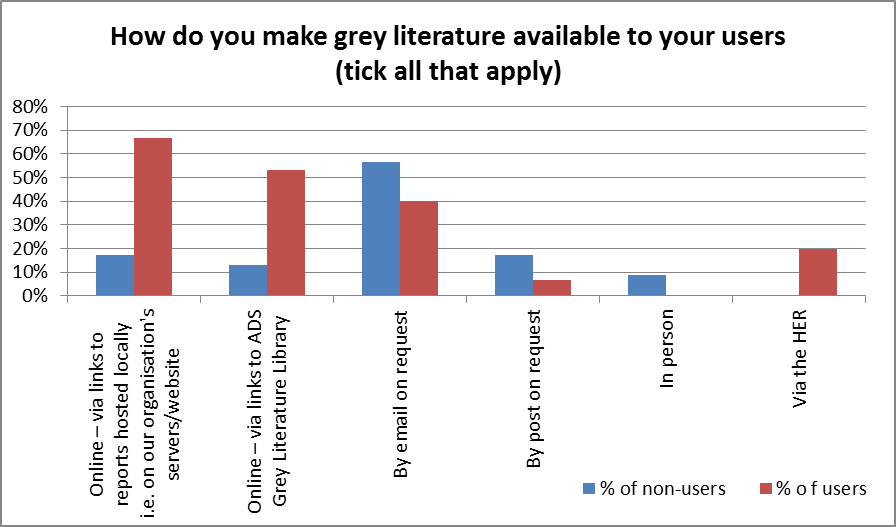This is the final instalment of the findings from the HERALD survey and covers the returns from 56 of the total 516 respondents who defined themselves as academic staff or students.
- All but one of the respondents replied as individuals and it was an almost even split between university staff and students. Most respondents worked in England with about 10% working in Scotland and Wales. 60% of respondents came from medium sized departments and the types of work carried out were diverse with largest group being 30% of respondents doing general fieldwork, and the next largest group being post excavation specialists.
- 91% of respondents thought that fieldwork completed by academic staff should be recorded in local and national databases, only 77% thought student fieldwork should be recorded. After a number of questions informing non-users of the form what the form did 62% thought that they should record their projects in OASIS (25% did not do fieldwork or worked outside the UK).
- 66% of respondents do not use OASIS and only 10% use it for all their projects.
The main reasons for not using the OASIS form were that they didn’t know it existed (48%), didn’t know how it worked (24%) or hadn’t had any training (44%). Those who do use it (34% of all respondents) do so to add the report to the ADS grey literature library or to inform the HER of their fieldwork.
- 53% of users upload a report to their OASIS record at least 75% of the time, whilst almost a quarter never do. The most common reason for not uploading a report is that it is awaiting traditional publication (35%). 2 respondents (12%) did not want their report to be available online. Most grey literature can be seen to be made available online or by email for users where as non-users are mostly using email. 65% of non-users of OASIS think that accessing grey literature online has positively affected their work whereas 100% of users think it has had a positive effect.
- 87% of non-users do not know what a DOI is whereas 66% of users do and 40% use them to link to reports online. This reflects the general difference in awareness between the two groups of the functionality of OASIS and how the data is used.
- Standards: 76% of users of OASIS refer to research frameworks in their work and the same amount think that OASIS has had a positive effect on data standards. 21% use the FISH toolkit, half have heard of it but don’t use it and 28% have never heard of it.
- Over half of OASIS users reported a problem with the validation stage of the OASIS workflow. It is interesting that some HERs say that OASIS is the only way they hear about some academic projects but the academics still say that they have a problem with records getting stuck at the validation stage – this might be related to the fact that a relatively high proportion of records from academics have no report attached and are therefore not seen as a priority for validation.
- Users of the OASIS form generally welcomed the addition of bespoke sections for building recording, specialist reports, museum involvement and the use of the EH events thesaurus with positive answers by 80-90% of respondents. There was 100% support for community archaeologists using the form and more than 80% support for uploading records in bulk and using OASIS to record backlog projects. Non-users were rather more wary of additional sections, comments suggesting that this was due to poor knowledge of the system. They favoured Museum inclusion, use of the EH event thesaurus and uploading backlog reports but were not so keen on having a people upload reports for building recording and specialist information.
- Interface and workflow improvements that academics particularly highlighted included being able to locate projects using a map for data entry and being able to control email notifications. They were also positive about direct communications with HERs and for EH to validate where HERs are not. There was a general feeling that access to records should be improved possibly through the Heritage Gateway.
“Records being available in Heritage Gateway would be good. Perhaps a link of some kind to the records would be just as useful if Heritage Gateway cannot handle the data themselves. An OASIS ID is usually there somewhere but the more information available and the easier it is to access the better.”
- Communication: both users and non-users favoured communication via the website and email lists, however the blog and social media were relatively popular with this user group.
- Training: 100% of non-users and 75% of users had had no training in OASIS. A downloadable manual, online videos were the most popular forms of training for both groups. Group workshops and helpdesk provision were also popular with non-users.
- The best thing about OASIS was the collection of records and reports from archaeological work across England and Scotland.
“It’s pretty much the only central repository we have of ongoing archaeological investigation in England complete with grey literature reports. It feeds into the Excavation Index and NMR, and includes records from the AIP. Now the AIP is being discontinued, the OASIS system is the best method for tracking grey literature production in England.”
The worst things included the time consuming data entry, that it seems designed for recording commercial work and delays in HER validation. Improvements included different types of interface for different users, multiple people being able to access and update one OASIS record, more training for users so that records are more consistently completed and more publicity in university teaching and community groups.
I hope you’ve found these round ups of the results from the HERALD survey useful and the final report with the general findings and recommendations will be available in the near future and will be announced on this blog.


